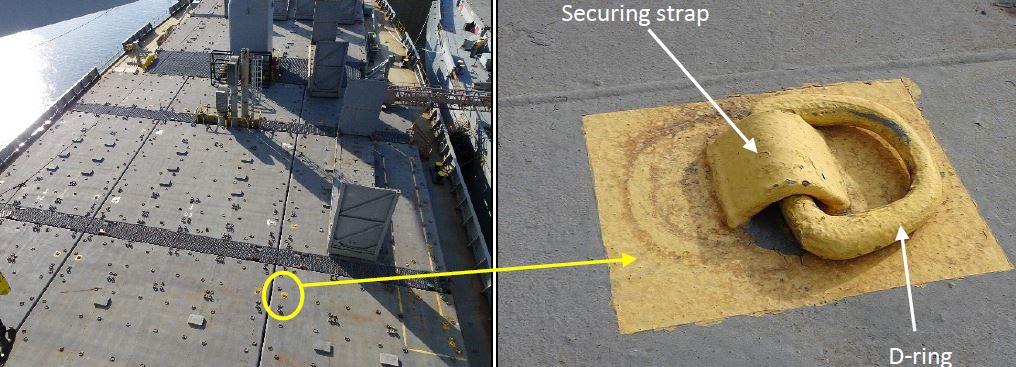Hidden Corrosion on Deck Fittings Can Cause Dangerous failures
The US Coast Guard (USCG) has shared lessons from a marine casualty that resulted in a severe injury to a crewmember onboard a cargo vessel. The incident brought to light a dangerous and potentially fatal situation involving hidden corrosion on D-ring lifting points. Three of four lifting points failed during positioning of a removable hatch cover on the vessel. The resulting snap-back of the lifting sling assembly struck the crewmember in the head. A significant amount of corrosion was found beneath the paint and on the underside of the straps.
There were no records of any testing conducted on the lifting points since their installation in the mid-1980s. Nor were there any records of any D-ring replacements, indicating that they had likely been in an exterior weather deck environment for several decades. Similar failures may occur in the absence of an established inspection and maintenance program.
The USCG strongly recommends that vessel owners, operators, marine surveyors and other maritime stakeholders:
- Immediately identify high-risk D-rings and similar lifting-point fittings. High risk factors include: Age, weather exposure, and lifting load. These factors will cumulatively cause corrosion losses on the fitting, increasing its stress and fatigue vulnerability during each lifting cycle.
- Thoroughly inspect all high-risk lifting points for damage, hidden corrosion, and wastage. Audio gauging, pull-testing, or even replacement may be appropriate.
- Consult with the manufacturer’s instructions to ensure safe lifting limits are in place and that the effects of service life are considered in their determination.
- Establish a maintenance schedule for periodically inspecting all lifting points and audio gauging or testing any fittings as they age into high-risk status
Please click here for the full alert
Please click here for previous Safety Alerts: https://ichca.com/safety-alerts
We are grateful to the United States Coast Guard for providing details. We acknowledge their commitment to sharing learning to benefit others. If you have similar operations, please share this information with managers, operatives and any potentially affected third parties as appropriate. Please also review any of your relevant operations for similar hazardous conditions, risks, and controls. Learning content like this is highly valuable as it is based on real-world experience. We encourage everyone with publishable information about incidents to send it to us, so that we can raise awareness across the whole industry. Please contact us at secretariat@ichca.com; sharing your insight could save a life or prevent injury.
The following has been compiled to provide an overview of some of the safety principles associated with this type of operation. Any lifting operation of this type should be undertaken by competent persons in compliance with applicable regulatory frameworks and is the responsibility of the duty holder.
The use of gantry cranes and spreaders is the optimal and preferred method for lifting ISO containers and tanks (collectively referred to as Cargo Transport Units, CTUs) in most situations. However, not all terminals have this equipment available. At some terminals it is therefore accepted practice to lift ISO containers and tanks using wires or chains and single-rope cranes, such as mobile harbour cranes or barge-mounted derricks.
Safety should always be considered in any lifting operation and this alert sets out some key principles when lifting any cargo including containers by hook and chain or wires.
Please click the for the full Operational Alert
If you have similar operations, please share this information with managers, operatives and any potentially affected third parties as appropriate. Please also review any of your relevant operations for similar hazardous conditions, risks, and controls. Learning content like this is highly valuable as it is based on real-world experience. We encourage everyone with publishable information about incidents to send it to us, so that we can raise awareness across the whole industry. Please contact us at secretariat@ichca.com; sharing your insight could save a life or prevent injury.

